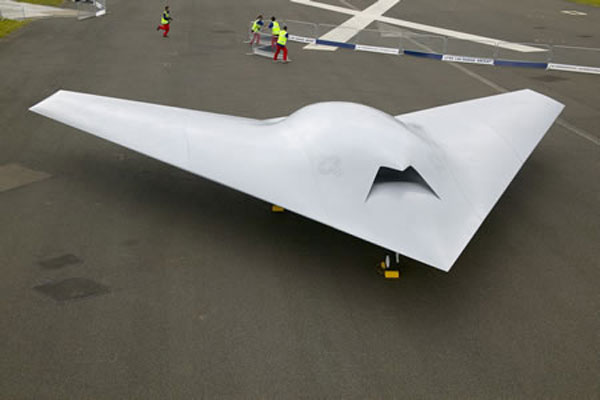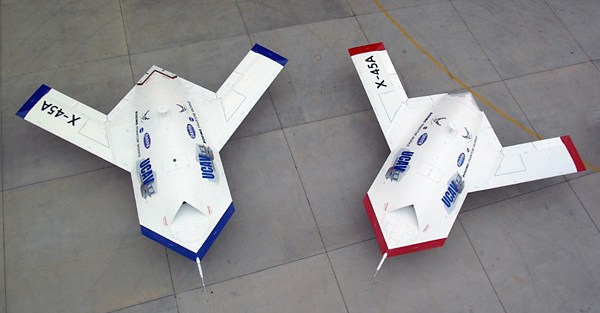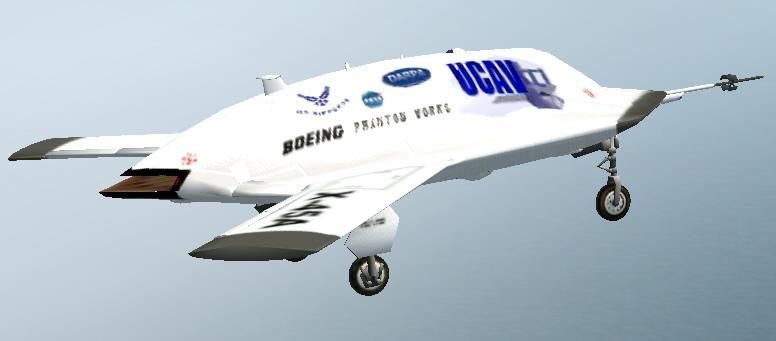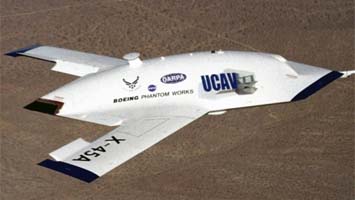Boeing X-45
The Boeing X-45 Spiral is an unmanned combat aircraft (English: Unmanned Combat Air Vehicle, UCAV ) which is designed to demonstrate the next generation of autonomous combat aircraft of Boeing Phantom Works.
The X-45 is manufactured by Boeing Integrated Defense Systems and is part of the J- UCAS project (Joint Unmanned Combat Air System) DARPA. After canceling the program, Boeing developed the X -45C Phantom Ray to continue.
Development
Boeing developed the X-45 research results that have been achieved in the development of the Boeing Bird of Prey. X -45 has an extremely flat engine inlet, which is located near the leading edge of the aircraft. The body goes into the lambda wing, in which there are also narrow exhaust outlets. X -45 has no fin - the split aileron act at the blade tips as asymmetric air brake, which is used as a rudder.
Models
Boeing built two X -45A reduced to show that the concept works. The larger X - 45B was later modified for X -45C, and for an increased range (up to 1930 km ) equipped with larger fuel tanks. The leading edge of the wing extends from the wing tip and the nose of the aircraft, similar to Northrop B-2. The first X -45C is to be completed by 2006. 2007 should then be started with the performance demonstrations. Boeing hopes that by 2010, the automatic air refueling from a Boeing KC -135 will be operational. Boeing was already represented by a dummy of the X -45C on some airshows. An entity known as the X - 45N and adapted for marine use version was shown as a mock-up on the Farnbourough International 2006.
Financing
In October 2004, the X -45C project part received 767 million U.S. dollars from DARPA to build the three aircraft and test. In July 2005, the DARPA paid another 175 million U.S. dollars to continue the project and to develop the autonomous aerial refueling. On 2 March 2006, the United States Air Force decided not to continue the X -45C project. Boeing is now trying to align the airplane on the needs of the United States Navy.
Flight operations
The X -45A had its maiden flight on 22 May 2002. The first generation of UCAVs is mainly used for air -to-ground and defending air - to-air combat, with a pilot by remote control still takes a great deal of control. On 18 April 2004, the first bombing test at Edwards Air Force Base was successfully performed.
On February 4, 2005, on its 50th flight, the X -45A launched in patrol formation and were then pointed to the presence of a target. The X -45A set then automatically determines which aircraft had the optimum position, weapons, and fuel quantity to attack the target accordingly. After this process, an X -45A changed its course and the monitoring pilot was cleared to attack on a simulated air defense position. After this successful attack, the X -45A detected independently a further hidden agenda, and a second X -45A destroyed it. This test demonstrated how the planes work autonomously as a team and manage their resources. It has also been shown that undetected targets can be automatically detected and destroyed, which is significantly heavier than the attack on a hard-coded target.










